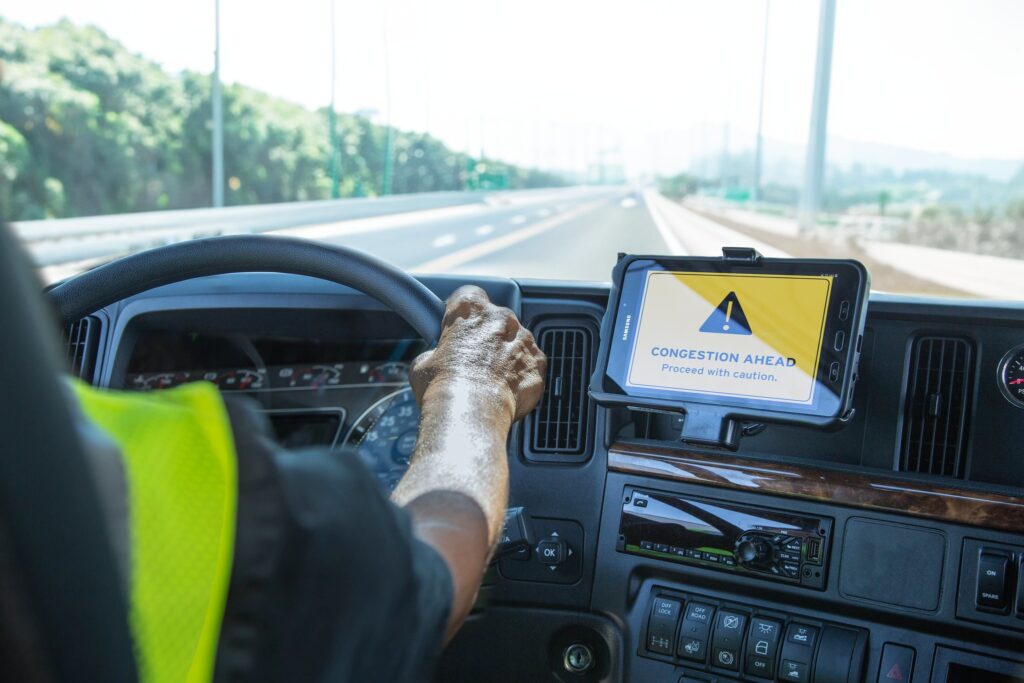New Drivewyze Mobile App Unlocks Free In-Cab Safety Alerts
Warns Drivers of Upcoming Dangerous Curves, Low Bridges, Sudden Slowdowns, and More
Drivewyze, a technology leader with innovative safety and productivity solutions for fleets, drivers, and transportation agencies, has announced a major update to its popular mobile app. It now includes free in-cab Safety Notifications that alerts drivers as they approach hazards along their routes. The updated mobile app, which also boasts an improved user experience, is available to drivers and owner operators through the app store for Android and is coming soon for iOS. The Safety Notifications are being offered as an unlimited free service – no subscription or trial required. It runs on the same app used by drivers to access Drivewyze PreClear, the nation’s largest weigh station bypass service.
Free Safety Notifications are just a tap away on a tablet or smartphone and provide alerts for drivers prior to dangerous curves, low bridges, steep mountain grades, as well as sudden slowdowns and upcoming work zones in select states. Visual messages, such as “high rollover,” and “sudden slowdown ahead,” are displayed in conjunction with an audible chime. These notifications are also available to subscribers of Drivewyze PreClear weigh station bypass and for those using Drivewyze Safety+.
“We wanted to expand the use of Safety Notifications, especially with owner-operators and smaller fleets,” said Martin Murtland, VP of Product at Drivewyze. “Drivers operate on unfamiliar roads all the time and we’re giving them added ‘vision’ as to what’s ahead. With state agencies collaborating with us to provide real-time alerts on hazardous areas and dangerous traffic conditions, the added visibility in-cab continues to grow.”
Murtland said Drivewyze was built around providing technology that improves truck safety. “The response we’ve received from fleets and drivers – and vitally the documented benefits of proactive in-cab alerts – inspired us to offer these alerts to all drivers, free of charge. Our alerts will benefit truckers, other motorists, and those working in construction zones through safer roadways.”
One of the most important times to alert drivers is when a vehicle is approaching a known dangerous curve. The latest data from NHTSA showed that there were more than 19,000 rollovers involving heavy trucks in 2020. Nearly 600 fatalities resulted. “Drivers receiving our alerts on dangerous on/off ramp curves have slowed down, on average, by 4 mph,” said Murtland. “That’s significant and has helped numerous truckers avoid a rollover.” More than 630 dangerous curves have been geo-fenced by Drivewyze in the U.S. and Canada.
Drivewyze also provides alerts on upcoming low bridges. In 2020 NHTSA reported close to 15,000 bridge strikes by vehicles. “Data we’ve gathered shows that 65 percent of drivers turn off their navigation after the first mile of their route and don’t turn it back on until the final mile,” said Murtland. “That can lead to a drive down an unfamiliar street and ultimately a low bridge strike. But our app, running in the background, can help a driver avoid that possibility by notifying the driver to any of the 1,616 low bridges we’ve identified as too low for trucks.”
When it comes to sudden slowdowns on interstates and highways, Drivewyze’s Smart Roadways program works with participating states to provide additional free in-cab alerts. Seven state agencies are involved in the program with more states to be added soon. Fully automated messages such as “Sudden Slowdown Ahead,” and “Congestion Ahead” are displayed two to three miles in advance. A study in North Carolina on I-95 found that commercial truck drivers receiving Drivewyze in-cab notification reduced speed by an average of 11 mph after drivers were alerted of a sudden slowdown, and by an average of 8 mph reduction when alerted about a congestion event.
“According to the FMCSA, 30% of all crashes are on interstates — and many are secondary incidents where a truck or car rear-ended a vehicle that was in queue from the initial crash – it highlights the importance of these alerts that give earlier warning to drivers. For example, a study by PennDOT on Secondary Crashes found that nearly half of secondary crashes happened in traffic queues of 60 minutes or longer,” said Murtland.
Category: Accessories, Connected Fleet News, Driver Stuff, Equipment, Featured, Fleet Diagnostics & Software, Fleet Tracking, General Update, News, Safety, Tech Talk, Tools











